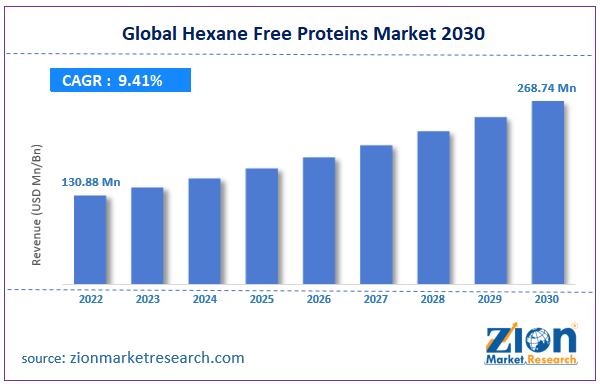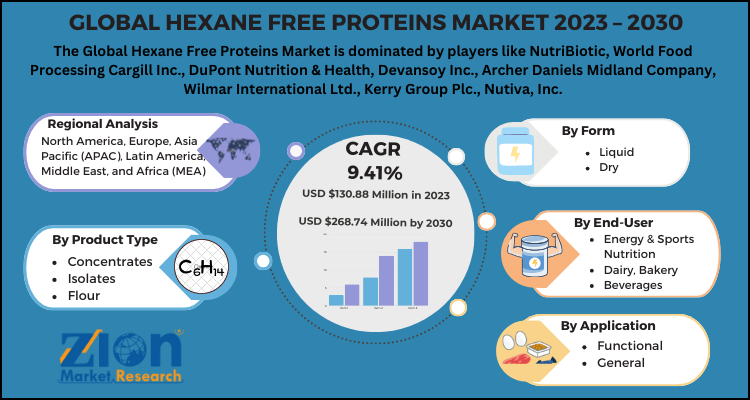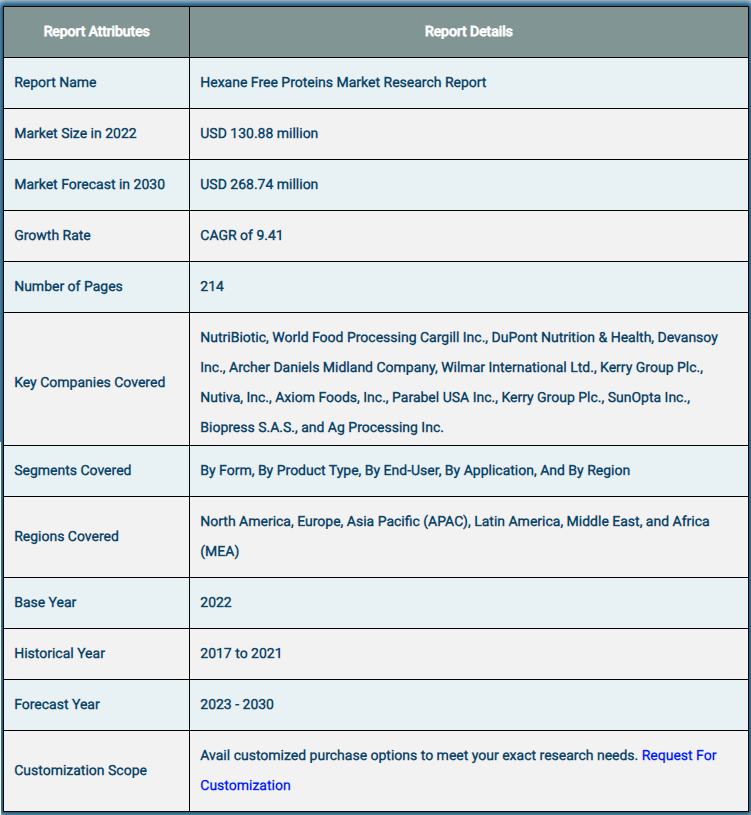Hexane Free Proteins Market Size, Share, Growth Report (2024–2032)
Hexane Free Proteins Market Size, Share, Growth Report (2024–2032)
Blog Article
Based on estimates, the size of the global market for hexane-free proteins was valued at USD 130.88 million in 2022 and is expected to increase to USD 268.74 million by 2030, with a compound annual growth rate (CAGR) of around 9.41% from 2023 to 2030. The market for hexane-free proteins has grown dramatically, largely due to consumer desire for clean-label and sustainable food ingredients. Recent studies predict that the market will continue to expand, with leading players contributing to the overall market share of the sector.
Introduction
The hexane free proteins market is gaining traction as consumers increasingly seek healthier, more sustainable food options. Hexane, a solvent traditionally used in the extraction of proteins from various plant sources, has raised health concerns due to potential residues in food products. As a result, there is a growing demand for hexane-free extraction methods that ensure the purity and quality of protein ingredients. This article explores the current landscape of the hexane free proteins market, highlighting key trends, growth drivers, challenges, and future projections.
The market overview of hexane-free proteins
Hexane free proteins are derived from various plant sources, including soy, peas, rice, and hemp, using extraction methods that do not involve the use of harmful solvents. This results in higher-quality protein products that are often more appealing to health-conscious consumers. The market for hexane free proteins is expanding, driven by the increasing popularity of plant-based diets and the rising awareness of food safety.

Hexane is the by product of the petrol production process. To extract edible oils from the seeds and vegetables, hexane is utilised. The Environmental Protection Agency states that hexane is a synthetic, neurotoxic, explosive, and hazardous air pollutant chemical. Hexane is a generic processing aid that divides the beans into proteins and lipids in soy oil, soy meal, and soy food ingredients.
Segmentation of the Hexane Free Proteins Market
Hexane-free proteins have a fragmented global market based on form, product type, application, and end user. The global market is divided into three segments based on the kind of product: flour, isolates, and concentrates. The market is divided into functional and general applications based on application. There are more sub-segments within the functional segment, including baking, nutritional supplements, and general foods. The general portion is further divided into emulsification, dispersibility, and other categories. The market is divided into liquid and dry segments based on form. The market is segmented into energy and sports nutrition, dairy, bakery, drinks, and other categories based on the end-user.

The market for hexane-free proteins: growth factors
The use of hexane ingredients in processed food products is imposing more and more legal restrictions on the market for hexane-free proteins. Other factors driving this market include population growth, increased awareness of the health benefits of utilising hexane-free proteins, and rising end-user consumption of soy proteins. The functional qualities of hexane-free proteins and the longer shelf life of processed foods are the major elements driving the market’s expansion. The market for hexane-free proteins will grow more slowly due to a few factors, such as food allergies that impede market expansion and a lack of knowledge about the negative effects of hexane consumption. Additionally, proper testing for the presence of hexane in food products will be lacking.
Market for Hexane-Free Proteins: Report Scope

Market Study: Hexane-Free Proteins by Region
The global market for hexane-free proteins is divided into several regions, including North America, Western Europe, Asia Pacific, Latin America, Eastern Europe, and the Middle East and Africa, according to the geographical segmentation. The market for hexane-free proteins is dominated by North America, with Europe following closely behind. The Asia Pacific market is expanding at a very quick pace as well. Advanced technology, the existence of R&D centres, high disposable income, greater consumer awareness of healthful food options, and better production facilities are the factors driving market expansion in the Asia Pacific region. The market in the Middle East and Africa has enormous potential because of things like rising rates of expenditure on processed foods and rising demand for nutrient-dense foods.
Key Market Segments
By Source
- Soy Protein: A leading source, used in various food products, including meat alternatives, protein bars, and beverages.
- Pea Protein: Gaining popularity for its high digestibility and allergen-friendly profile.
- Rice Protein: Often used in sports nutrition products due to its amino acid profile.
- Hemp Protein: Known for its omega-3 fatty acids and fiber content, appealing to health-focused consumers.
By Product Type
- Isolates: Highly concentrated protein forms that are often used in supplements and food products.
- Concentrates: Lower protein content than isolates but retain more nutrients, suitable for various food applications.
- Textured Proteins: Often used in meat alternatives, providing texture and mouthfeel.
By Application
- Food and Beverages: Including plant-based meat alternatives, protein bars, and dairy substitutes.
- Nutraceuticals: Protein supplements and functional foods that promote health benefits.
- Animal Feed: Increasingly used as a sustainable protein source in livestock feed.
- Cosmetics and Personal Care: Incorporation of plant-based proteins into beauty products for skin and hair health.
By Region
- North America: A significant market driven by high demand for plant-based products and health-conscious consumers.
- Europe: Strong growth due to increasing awareness of clean-label products and sustainability.
- Asia-Pacific: Fastest-growing region, with rising disposable incomes and a growing trend towards healthy eating.
- Latin America and Middle East & Africa: Steady growth as plant-based diets gain popularity.
Market Dynamics
Drivers
- Consumer Awareness and Health Trends: Growing awareness of health benefits associated with hexane-free proteins is encouraging consumers to choose natural and clean-label products.
- Sustainability and Environmental Concerns: The shift towards sustainable food production and consumption is driving the demand for plant-based, hexane-free protein sources.
- Regulatory Push for Food Safety: Increasing regulations regarding food safety and the use of solvents in food processing are favoring hexane-free extraction methods.
- Innovation in Food Technology: Advances in extraction and processing technologies are enhancing the availability and quality of hexane-free proteins.
Challenges
- Higher Production Costs: Hexane-free extraction methods can be more expensive than traditional methods, potentially impacting product pricing.
- Competition from Conventional Proteins: The market faces competition from conventional protein sources, including animal proteins, which may be perceived as more affordable and widely accepted.
- Limited Awareness: While the trend is growing, there is still limited consumer awareness about the benefits of hexane-free proteins compared to traditional options.
Emerging Trends
- Growth of Clean Label Products: Consumers are increasingly seeking transparency in food labeling, favoring products that are free from artificial ingredients and harmful chemicals.
- Plant-Based Meat Alternatives: The rise of plant-based diets has led to a surge in demand for hexane-free proteins used in meat substitutes, as consumers look for healthier options.
- Functional Foods: The trend towards functional foods that offer additional health benefits is driving innovation in hexane-free protein formulations.
- Personalized Nutrition: The emergence of personalized nutrition solutions that cater to individual dietary needs and preferences is influencing the development of new protein products.
Future Outlook
The hexane free proteins market is set for significant growth, driven by rising consumer demand for clean and sustainable protein sources. As health consciousness continues to rise, and as innovative extraction technologies improve product availability and quality, the market will likely see further expansion in the coming years.
Companies that prioritize sustainable practices, product innovation, and consumer education will be well-positioned to capitalize on the growing interest in hexane-free proteins.
Conclusion
The hexane free proteins market is evolving rapidly as consumers seek healthier and more sustainable food options. With rising awareness of food safety and environmental concerns, hexane-free proteins are becoming increasingly popular across various applications, from food and beverages to nutraceuticals. As the market adapts to consumer preferences and embraces emerging trends, companies focusing on innovation and sustainability will play a key role in shaping the future of the hexane free proteins market.
Get to know better
Restaurant POS Software Market
Autonomous Luxury Vehicle Market
Operating Room Management Market
Contact Us:
Zion Market Research212
USA/copyright Toll Free: 1 (855) 465–4651
Network: 1 (302) 444–016611
Web: https://www.zionmarketresearch.com/
Blog: https://zmrblog.com/
Report this page